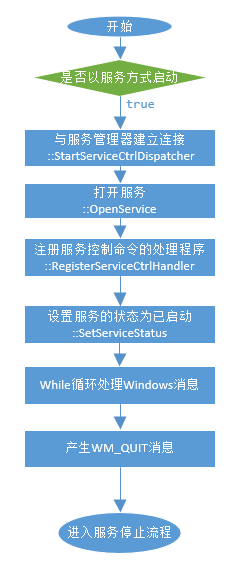通过研究Windows服务注册卸载的原理,感觉它并没有什么特别复杂的东西,Windows服务正在一步步退去它那神秘的面纱,至于是不是美女,大家可要睁大眼睛看清楚了。
接下来研究一下Windows服务的启动和停止的流程。
启动流程
启动时自然是从程序的入口点开始
extern "C" int WINAPI _tWinMain(HINSTANCE /*hInstance*/, HINSTANCE /*hPrevInstance*/, LPTSTR /*lpCmdLine*/, int nShowCmd) { //这里是程序的入口点,直接调用了ATL框架中的CServiceModuleT类的WinMain方法 return _AtlModule.WinMain(nShowCmd); }
接下来进入_AtlModule.WinMain查看细节。
//处理命令行参数后,开始启动 if (pT->ParseCommandLine(lpCmdLine, &hr) == true) hr = pT->Start(nShowCmd);
WinMain方法中,主要是对命令行参数进行处理后,调用Start方法进行启动。
HRESULT Start(_In_ int nShowCmd) throw() { T* pT = static_cast<T*>(this); // Are we Service or Local Server CRegKey keyAppID; LONG lRes = keyAppID.Open(HKEY_CLASSES_ROOT, _T("AppID"), KEY_READ); if (lRes != ERROR_SUCCESS) { m_status.dwWin32ExitCode = lRes; return m_status.dwWin32ExitCode; } CRegKey key; lRes = key.Open(keyAppID, pT->GetAppIdT(), KEY_READ); if (lRes != ERROR_SUCCESS) { m_status.dwWin32ExitCode = lRes; return m_status.dwWin32ExitCode; } TCHAR szValue[MAX_PATH]; DWORD dwLen = MAX_PATH; //读取注册表信息 //通过regserver方式注册服务,则lRes为ERROR_SUCCESS //通过service方式注册服务, 则lRes不等于ERROR_SUCCESS lRes = key.QueryStringValue(_T("LocalService"), szValue, &dwLen); m_bService = FALSE; if (lRes == ERROR_SUCCESS) m_bService = TRUE; if (m_bService) { //以Windows服务的方式运行 SERVICE_TABLE_ENTRY st[] = { { m_szServiceName, _ServiceMain }, { NULL, NULL } }; if (::StartServiceCtrlDispatcher(st) == 0) m_status.dwWin32ExitCode = GetLastError(); return m_status.dwWin32ExitCode; } // local server - call Run() directly, rather than // from ServiceMain() //以普通应用程序的方式运行 m_status.dwWin32ExitCode = pT->Run(nShowCmd); return m_status.dwWin32ExitCode; }
Start方法中会根据读取到的注册表信息,来决定是否以服务的方式运行。如果是通过RegServer方式注册服务,则以普通程序运行;如果是通过Service方式注册服务,则以Windows服务的方式运行。
普通程序方式运行,不在本文的讨论范围之内,下面来看一下以Windows服务方式运行的过程。
以Windows服务方式运行的话,程序会调用StartServiceCtrlDispatcher方法,看一下关于此方法的MSDN的解释
Connects the main thread of a service process to the service control manager, which causes the thread to be the service control dispatcher thread for the calling process. Remarks When the service control manager starts a service process, it waits for the process to call the StartServiceCtrlDispatcher function. The main thread of a service process should make this call as soon as possible after it starts up (within 30 seconds). If StartServiceCtrlDispatcher succeeds, it connects the calling thread to the service control manager and does not return until all running services in the process have entered the SERVICE_STOPPED state. The service control manager uses this connection to send control and service start requests to the main thread of the service process. The main thread acts as a dispatcher by invoking the appropriate HandlerEx function to handle control requests, or by creating a new thread to execute the appropriate ServiceMain function when a new service is started.
这段话的大意是 “调用此方法可以与服务管理器建立连接,这样服务管理器就可以管理服务的状态”,实际是服务管理器发出命令后,服务可以对接收到的命令进行响应。
“当服务管理器启动一个服务进程,服务管理器会等待服务进程调用StartServiceCtrlDispatcher方法。服务进程的主线程必须确保此方法在30秒内被尽快的执行。如果StartServiceCtrlDispatcher方法成功与服务管理器建立连接,那么它会等到服务的状态变为SERVICE_STOPPED后才返回”。
由此可知,当Start方法调用StartServiceCtrlDispatcher后,会进入到_ServiceMain方法。
void ServiceMain( _In_ DWORD dwArgc, _In_reads_(dwArgc) _Deref_pre_z_ LPTSTR* lpszArgv) throw() { lpszArgv; dwArgc; // Register the control request handler m_status.dwCurrentState = SERVICE_START_PENDING; m_dwThreadID = GetCurrentThreadId(); //注册命令处理程序,用于响应服务管理器的控制命令 RegisterServiceCtrlHandler(m_szServiceName, _Handler); //设置服务的状态为已启动 SetServiceStatus(SERVICE_START_PENDING); m_status.dwWin32ExitCode = S_OK; m_status.dwCheckPoint = 0; m_status.dwWaitHint = 0; T* pT = static_cast<T*>(this); // When the Run function returns, the service has stopped. m_status.dwWin32ExitCode = pT->Run(SW_HIDE); //当Run方法结束后,会设置方法的状态为已停止 SetServiceStatus(SERVICE_STOPPED); }
_ServiceMain方法中主要是注册了一个服务控制命令的处理程序,然后设置服务的状态为已启动,然后调用Run方法。
HRESULT Run(_In_ int nShowCmd = SW_HIDE) throw() { HRESULT hr = S_OK; T* pT = static_cast<T*>(this); //初始化Com相关的东西 hr = pT->PreMessageLoop(nShowCmd); if (hr == S_OK) { //处理Msg消息 pT->RunMessageLoop(); } if (SUCCEEDED(hr)) { //释放Com相关资源 hr = pT->PostMessageLoop(); } return hr; }
Run方法中主要是循环处理Msg消息,防止主线程退出。
至此,服务算是完全启动了。
前面看到_ServiceMain方法中注册了一个服务控制命令处理程序,接下来看一下这个方法做了什么。
void Handler(_In_ DWORD dwOpcode) throw() { T* pT = static_cast<T*>(this); switch (dwOpcode) { //停止命令 case SERVICE_CONTROL_STOP: pT->OnStop(); break; //暂停命令 case SERVICE_CONTROL_PAUSE: pT->OnPause(); break; //恢复命令 case SERVICE_CONTROL_CONTINUE: pT->OnContinue(); break; case SERVICE_CONTROL_INTERROGATE: pT->OnInterrogate(); break; case SERVICE_CONTROL_SHUTDOWN: pT->OnShutdown(); break; default: pT->OnUnknownRequest(dwOpcode); } }
可以看到,这个方法根据不同的控制命令,做了不同的处理。
Windows服务的启动流程总结

停止流程
上面我们看到当服务接收到停止服务的命令后,Hanlder方法会通过调用pT->OnStop方法来进行处理。
void OnStop() throw() { SetServiceStatus(SERVICE_STOP_PENDING); ::PostThreadMessage(m_dwThreadID, WM_QUIT, 0, 0); }
OnStop方法中,通过SetServiceStatus方法来设置服务状态为正在停止。并通过PostThreadMessage产生一个WM_QUIT的消息。
void RunMessageLoop() throw() { MSG msg; while (GetMessage(&msg, 0, 0, 0) > 0) { TranslateMessage(&msg); DispatchMessage(&msg); } }
此时RunMessageLoop中的While循环中断。
While循环中断后会通过SetServiceStatus设置服务状态为已停止。
然后WinMain方法执行结束,服务进行退出。
这就是整个的服务停止流程。
Windows服务的停止流程总结

给服务添加自己的启动和停止时的处理
既然已经对Windows服务的启动和停止的流程有了一个大概的了解,那么给服务添加自己的启动和停止时的处理也就相对简单了一些。
下面是我的实现代码
class CServicesModule : public ATL::CAtlServiceModuleT< CServicesModule, IDS_SERVICENAME > { public : DECLARE_LIBID(LIBID_ServicesLib) DECLARE_REGISTRY_APPID_RESOURCEID(IDR_SERVICES, "{0794CF96-5CC5-432E-8C1D-52B980ACBE0F}") HRESULT InitializeSecurity() throw() { // TODO : 调用 CoInitializeSecurity 并为服务提供适当的安全设置 // 建议 - PKT 级别的身份验证、 // RPC_C_IMP_LEVEL_IDENTIFY 的模拟级别 // 以及适当的非 NULL 安全描述符。 return S_OK; } //服务启动 HRESULT Load(); //服务停止 HRESULT UnLoad(); HRESULT Run(_In_ int nShowCmd = SW_HIDE) throw() { HRESULT hr = S_OK; OutputDebugString(_T("准备启动服务")); hr = Load(); if(hr) { OutputDebugString(_T("启动服务失败")); return hr; } OutputDebugString(_T("Services服务已启动")); hr = ATL::CAtlServiceModuleT< CServicesModule, IDS_SERVICENAME >::Run(nShowCmd); hr = UnLoad(); OutputDebugString(_T("Services服务正常退出")); return hr; } }; CServicesModule _AtlModule; // extern "C" int WINAPI _tWinMain(HINSTANCE /*hInstance*/, HINSTANCE /*hPrevInstance*/, LPTSTR /*lpCmdLine*/, int nShowCmd) { return _AtlModule.WinMain(nShowCmd); } HRESULT CServicesModule::Load() { OutputDebugString(_T("服务正在启动")); return 0; } HRESULT CServicesModule::UnLoad() { OutputDebugString(_T("服务正在停止")); return 0; }
系列链接
玩转Windows服务系列——Debug、Release版本的注册和卸载,及其原理
玩转Windows服务系列——无COM接口Windows服务启动失败原因及解决方案
玩转Windows服务系列——Windows服务启动超时时间







 浙公网安备 33010602011771号
浙公网安备 33010602011771号